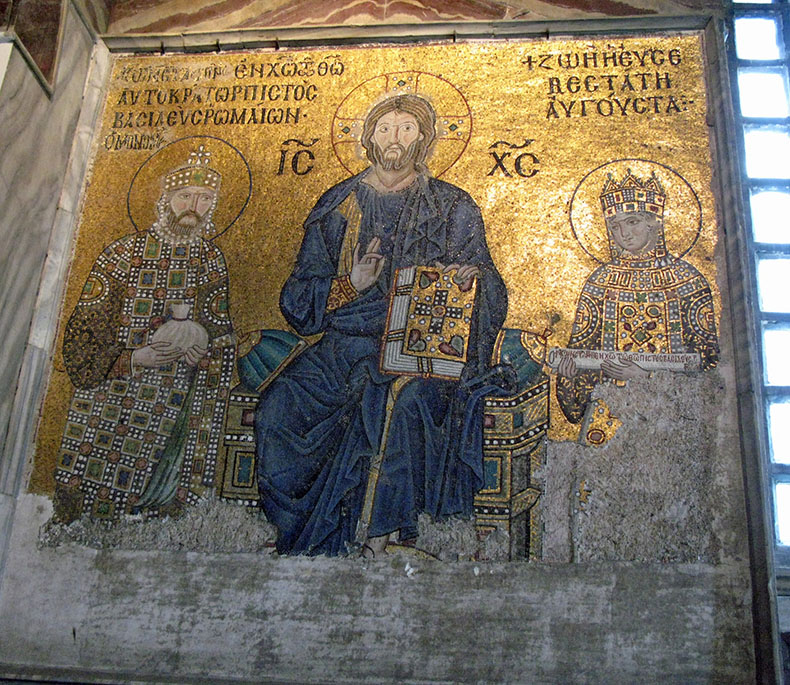
First I want to start by stating something in Zoe's favor. Despite the fact she poisoned at least one of her husbands and was a slave to luxury and other sensual vices, Zoe loved cats. This is certainly something in her favor and perhaps we should doubt some of the terrible stories that were told about her beacuse she was a cat-person. Is it possible a lover of cats could poison anyone? Well, yes, perhaps she was 'cat-like' in her killer instinct and how she played with her victims. Zoe's cat was named "Mechlempe", most likely a long-haired Persian. Many cat breeds had their origin in Anatolia and Armenia (the Van-Cat from Lake Van). Mechlempe had a long and happy life - he had his own caterers, cooks, waiters (who cut his food into pieces) and basket carriers. This fortunate feline ate from golden bowls!
Zoe was born in the Purple Chamber of the Great Palace to Constantine VIII who was co-emperor with his brother Basil II. Michael Psellos, who knew Zoe very well, has described her in detail at the age of 49:
"...was naturally... plumb, although not strikingly tall. Her eyes were large, set far apart, with imposing eyebrows. Her nose was inclined to be aquiline without being so. She had golden hair, and her whole body was radiant with the whiteness of her skin. There were few signs of age in her; in fact, if you marked well the perfect harmony of her limbs, not knowing who she was, you would have said that here was a young woman,for no part of her skin was wrinkled, but all sooth and taunt, with not furrows anywhere"
Zoe was the second child to her father with his wife Helena. Her father Constantine, was a man of enormous size - "nine feet tall" - was also very fat. He loved food and consumed an enormous amount of food in public, like Henry VIII. Constantine and Helena had three children - all girls. Zoe grew up in the palace in great luxury, protected by an army of court functionaries, eunuchs and church officials. As a woman she existed on the periphery of the court that was run my men and focused on the emperor.
Zoe seems to have been completely uninvolved in politics and to have lead a frivolous life, perhaps similar to Marie Antoinette when she was Dauphine of France. Growing up she would have received a good education in religion, Greek, history and foreign affairs. It would not have been necessary for her to learn Rhetoric - the art of public speaking - and things like law. When she was growing up there was always a chance that she might have been married off to some royal, although Byzantine Imperial brides were jealously guarded and always refused to foreigners. We don't know how secluded women's lived were during Zoe's lifetime. A hundred years later, during the reign of Manuel I there were wild sexual affairs were conducted - almost in public - by male and female members of the Imperial family that even involved incest. We only know about these events because we have surviving histories that describe them. Perhaps Zoe had lovers in her youth, we can only speculate.
One thing about Zoe that historians mention is how she loved making perfumes and cosmetics. Byzantine women generally made their own at home. Facial creams had a short shelf life and had to be mixed frequently to maintain their freshness. We have lists of all of the ingredients that were used to create lotions and perfumes. You could create your own blends. Even the emperor created his own perfumes and unguents; he took a field kit of essences along with braziers to burn them when him when he traveled or was on campaign; when the emperor traveled his vestiarion, or private suite, included two large cooler-basins for rose-water. Also in his vestiarion were various perfumes and unguents including:
Incense (probably myrrh from the Commiphora myrrha tree the source of myrrh resin, which is a natural gum)
Mastic (mastic is a Mediterranean shrub with a nice smelling resin obtained from its branches; it is similar to pine or cedar)
Frankincense (frankincense is also known as olibanum, an aromatic resin used in incense and perfumes, obtained from trees of the genus Boswellia. The word is from Old French franc encens ("high-quality incense")
Saccharin (I couldn't find anything on it, except as a sweetener)
Saffron (stamens of Crocus sativus, is is a small flower in the Iris family. Its profile is bittersweet, leathery, soft with an earthy base note)
Musk (was a name originally given to a substance with a strong odor obtained from a gland of the musk deer)
Ambergris (a waxlike substance that originates as a secretion in the intestines of the sperm whale, found floating in tropical seas and used in perfume manufacture)
Liquid and Dry Agalloch (the fragrant, resinous wood of an East Indian tree, Aquilaria agallocha, of the mezereum family, used as incense in Asia)
True Cinnamon of the first and second quality and Cinnamon wood (the Byzantines believed that giant "cinnamon birds" collected the cinnamon sticks from an unknown land where the cinnamon trees grew and used them to construct their nests. Cinnamon was much appreciated by the Byzantines, the emperor made an annual present of two apples and a stick of it to select recipients)
Zoe would have had all of these fragrances and more at her disposal. She was really an expert at the making if perfumes and lotions, this would have been a talent the Byzantines would have appreciated. Unfortunately for her immortal soul, Zoe also seems to have known her poisons, too! You can learn more about Byzantine flowers and perfumes by visiting this page.
The Imperial court had a very full calendar of public events and celebrations. There were also daily entertainments for the inner circle. The Byzantines loved music and dance. They played harps, guitars, zithers, cymbals, drums, flutes and even had water organs. Men and woman danced together and feasted together even in public; even Zoe probably danced and sang herself. We can be certain that their were members of the Imperial family who acted as moral cops who policed the behavior of its members and retainers. Zoe had a sister named Theodora who was forced into the convent. Although many of their servants were eunuchs and 'safe' around them, there were many men who were looking for sexual conquests in the palace. We know that there were babies born out of wedlock at court even among Imperial princesses.
In Zoe's time there were two emperors because her uncle Basil II was at war all the time and away from Constantinople. He seems to have despised court ceremony. Even so, whether you liked it or not, someone had to perform the daily ritual. It was one of the things that made the state appear strong and stable to the outside world. It also preoccupied the noble class with ceremony, processions and awards - which defanged potential rebellions in Constantinople - by enforced boredom and exhaustion.
Basil II had a brother who he shared the throne with how was happy in stay in Constantinople and perform the day-to-day cycle that was centered around the life of the emperor, much like the way Louis XIV organized his daily schedule. The Byzantine court ceremonial was very elaborate and involved thousands of participants on a daily basis. It began and ended with the rising of the emperor and his return to the Imperial bedchamber at night. The day consisted of long processions of nobles, court officials, Imperial guards who followed ancient ceremonies in the vast halls of the Great Palace and state government. The position of master of ceremonies was very important to managing everything and the Imperial court had many of them. It was a secular ballet with strong religious overtones. There were participants that might surprise us, like charioteers from the Hippodrome and vast numbers of people who sang and chanted, performing the role of cheerleaders to these events.
Like ancient Rome, Byzantium had its own Senate and senators who participated in the rule of the Empire. Although Byzantium was an Imperial Autocracy it was, at the same time, ruled by its laws. There was a professional class that supported Imperial rule, through study of the law and in service to the crown through the bureaucracy which ran the city of Constantinople and its Empire on a day-to-day basis. This professional class was paid annually, each man received his pay from the Emperor in bags of money. Every appointment came from him as well, every promotion was personally approved by the Emperor. In many cases Imperil bureaucrats received their emblems of office directly from him in elaborate ceremonies before the court. The Emperor was seen to take a personal interest in every aspect of their lives including their marriages and children. Members of the court at all levels were used to receive personal messages from the emperor. The vast bureaucracy that ran the empire was based on loyalty and service to the Emperor. There were clearly defined levels to every job along with uniforms, responsibilities and rewards that were associated with each one of them. Members of this ruling class expected to move up the chain of positions and receive the benefits that came from years of loyal service. They lived around the city - as close to the Great Palace as possible since the function of the court required them to be present from morning until sunset there and in the state buildings that surrounded it. Most of the departments of Imperial government where situated around the Great Palace. There were a thousand top-level officials with 20,000 lower level government workers under them.
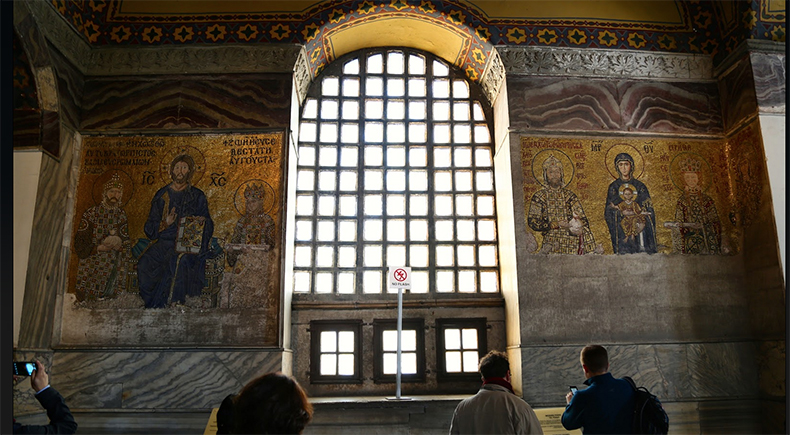 A vital part of the Imperial ceremony involved the church of Hagia Sophia, which was to the north of the palace and connected to it by public squares, state buildings and passageways from the palace. Most of the time the emperor and his family attended church in the chapels and churches nearest to their private rooms. The emperor was expected to attend services and religious ceremonies all day and frequently into the night. Some of these were quite short and others could include all night vigils. Those that took place deep within the palace were part of the ceremony that was witnessed and participated in by the Imperial court. The public never saw it unless the church service took place outside the confine of the Great Palace and their was a procession to its location.
A vital part of the Imperial ceremony involved the church of Hagia Sophia, which was to the north of the palace and connected to it by public squares, state buildings and passageways from the palace. Most of the time the emperor and his family attended church in the chapels and churches nearest to their private rooms. The emperor was expected to attend services and religious ceremonies all day and frequently into the night. Some of these were quite short and others could include all night vigils. Those that took place deep within the palace were part of the ceremony that was witnessed and participated in by the Imperial court. The public never saw it unless the church service took place outside the confine of the Great Palace and their was a procession to its location.
There were many events that took place in Hagia Sophia. The emperor was expected to attend all of the high Feast Days of Hagia Sophia and any special events- like Easter, Christmas, coronations and marriages. The emperor would set out from the Great Palace to Hagia Sophia in a procession. Public ones could go through the halls of the palace and into the Augusteion, the former agora of the city which later functioned as the forecourt to the Great Church. Thousands of people would watch these processions and end up participating as spectators in Hagia Sophia once the emperor got there.
There was a private path to the church that went from the Great Palace to the church via the Chalke Gate of the palace via an elevated passageway. It was attached to the southeastern side of the church and gave the Imperial family a private entrance to the church. The passageway ended in a great wooden spiral staircase that lead to both the ground floor of the church and to the eastern end of the South Gallery, which functioned frequently as an semi-private Imperial chapel. The use of the passageway allowed the emperor to attend services in Hagia Sophia without entering the church through the narthex and main doors of the nave. From this staircase the emperor could move up and down to the sanctuary of the church to participate in those services that required his physical presence and return to the palace afterwards.
The South Gallery was also the location were the Emperor and his family would meet the Patriarch and the clergy of Hagia Sophia. Every Easter the Emperor distributed the annual pay to the clergy of the church here. the South Gallery was also attached to the Patriarchal Palace which was connected to the south side of Hagia Sophia. The Patriarch used his own staircase here, which took him down into the nave of the church. He would regularly stand in the central bay of the South Gallery, overlooking the nave, and give the crowds there his blessing.
Zoe grew up with all of this ceremony. As a woman she did not participate in it fully and was never expected to do so. Her father, Constantine, was made co-emperor so he could perform the essential functions an emperor was required to do in Hagia Sophia. His brother and co-emperor, Basil II, was seldom in the city and was happy to leave all of this to his brother while he was with the army in the field. Zoe lived for 47 years in the palace, never married and witnessed all of the ceremony in Hagia Sophia as both spectator and participant. When her uncle died her father ruled for three years on his own. Alas, he had no sons to succeed him. In the hope of protecting the dynasty and the Empire Constantine married Zoe to a member of the nobility he chose for her, Constantine Dalassenos, who ended up being rejected before the wedding took place. Next Constantine choose Romanos Argyros, described by Psellos as " a man of heroic stature, who looked every inch a King" as her marriage partner. She married him and Romanus succeeded Constantine when he died, just three days after the marriage ceremony. Zoe was too old (50) to bear children so this was a dead-end for the Macedonian Dynasty. Zoe's sister Theodora, who she detested, was also too old, and a nun to boot.
Zoe prayed for a miracle and tried desperately to get pregnant, without success. Romanus quickly turned on his new wife, refused to sleep with her and took several mistresses. She conducted her own affairs, perhaps she thought another man might succeed in giving her the child she needed to continue the dynasty. Romanus forced Zoe to cut her living expenses as another way to get back at her and reduce her influence at court.
Romanos came to believe that Zoe and her servant/boyfriend, Michael Paphlagon (Psellos tell us he was "a finely proportioned young man, with the fair bloom of youth in his face, as fresh s a flower, clear eyed...and rosy red cheeked") were attempting to poison him, which was probably true. Romanos was discovered dying in his bath. On the same day he died Michael and Zoe were married and Michael IV was crowned as the new emperor in Hagia Sophia. Once he had the crown Michael VI came to believe Zoe was going to poison him, too, and shut her up in the palace under guard. Seven years later Michael became sick and died. Zoe had adopted another Michael as her successor, who was crowned as yet another emperor, Michael V. This new emperor banished forced Zoe to a convent and forced, against her will, to become a nun. Such bad luck for poor Zoe. You can read about what happened to one of Zoe's husbands at the Studion monastery by visiting this page.
The people of Constantinople rose up and overthrew Michael. They brought Zoe's sister, Theodora, very tall and thin, with a small head, to Hagia Sophia and forced her to be proclaimed Empress to rule alongside her. The mob then stormed the great Palace and forced Michael to flee to a monastery. Zoe was back on the throne. She soon has a new husband, Constantine Monomachos, who was crowned Constantine IX and reigned for eight years. Constantine was described as "a marvel of beauty, ...so justly proportioned, so harmoniously fashioned, that there was no one in our time to compare with him". Constantine came from the city of Antioch on the Orontes. It's highly likely he spoke Arabic and Syriac as well as Greek. He had many ties to his birthplace. After he became Emperor in 1052 he appointed a member of the Patriarchal clergy from Hagia Sophia, and a naive of Antioch, to become Petros III Patriarch of the city. He was very handsome and had reddish blond hair and beard.
All of Zoe's husbands, Romanos, Michael and Constantine, compelled the updating of this mosaic in Hagia Sophia. It's possible the mob in Hagia Sophia broke into the upper gallery and defaced the mosaic of the earlier emperor, obviously Constantine IX is a replacement. You can read all about this in the technical description of the mosaic below.
This mosaic had to be changed as soon as possible. Zoe and Constantine were in the South Gallery a lot. Plus Constantine had just made a big donation to Hagia Sophia that meant the clergy were able to conduct daily liturgy there. Prior to this the liturgy was only performed on Saturday, Sunday and Great Feast days. Now that her latest husband was emperor he was performing all of the Imperial ceremonies that were expected of a male ruler, including those that were performed in Hagia Sophia. It would have been HUGELY embarrassing to have the former husband visible over your head where ever you looked east in the South Gallery. All of these Imperial portraits are high up on the wall so you could not avoid seeing 'him'. In particular Constantine would have wanted this done by the next Easter so he could distribute the clergy of Hagia Sophia its salaries. It must have been a rush job; the inscription - changing the emperor's name to Constantine - looks terrible. Perhaps in time this became botched name became an inside joke for the clergy of the church when they told the story of all of Zoe's many husbands.
Hagia Sophia was always a Patriarchal church, the changing of the inscriptions and the faces would have been ordered by the Patriarch and executed by the church's own artists. The patriarch ordered changes to the composition. The original faces were more vertical - you can see this by looking at the cross of the crown of Constantine that is centered - and how the chin doesn't line up with the loros. The faces, Zoe's too, were altered to turn them towards Christ in humility. The decision to make this change was probably made by the Patriarch Michael Kerularios, who compelled the Emperor to bow to him.
I don't think a mob attacked the mosaic, had they done so there who have been evidence of hacking around the faces, which seem to have been carefully removed and redone. In planning for the replacement of the face of Zoe's husband the artists would have pointed out that that they were working with new mosaic cubes that would not match those used in Christ and Zoe's; they would have to be replaced as well. More paid work for the artists...
the following is thomas whittemore's technical description of zoe panel
The Zoe panel was rediscovered in July 1934 and work began in August by the Byzantine Institute led by Thomas Whittemore and a group of eleven craftsmen.
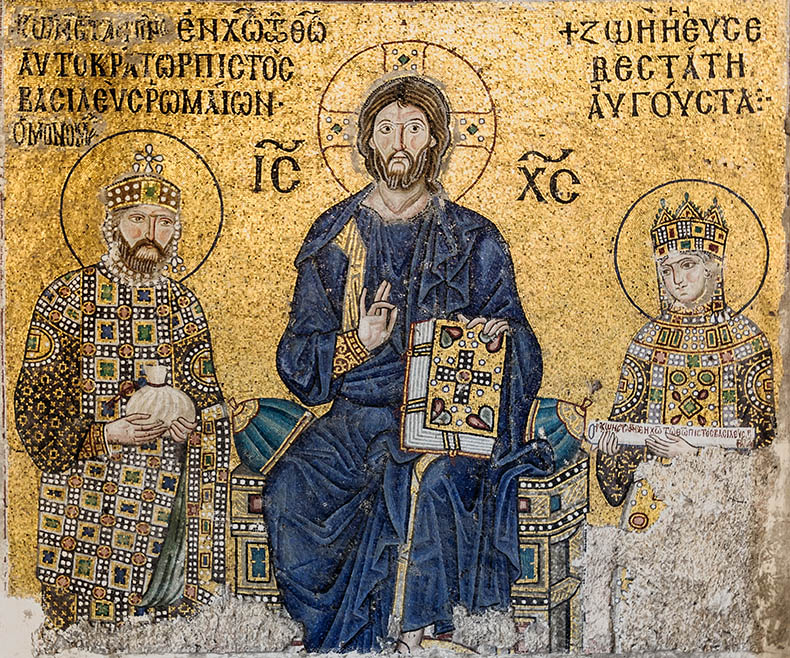
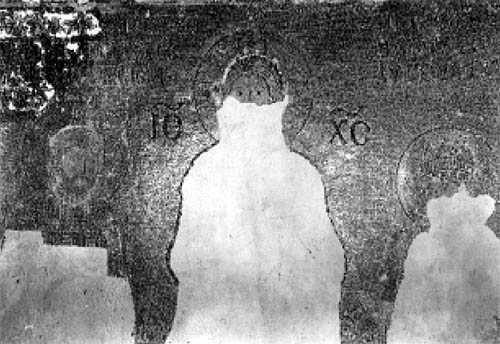 Originally the panel was a square 2.40 meters wide and 2.44 meters high. A strip of the mosaic, 35cm. in height, extending across the lower part, is now missing. Above this more tessellae are gone, exposing sections of the setting bed, and there are breaks in the mosaics surrounding the three heads, and in both Constantine inscriptions. These breaks strike an incongruous note and create a vital disorder in the picture. Indeed, scrutiny reveals the fact that all the existing heads have been substituted for earlier ones and that the ensuing tonal discord has rendered the original composition displastic and fragmentary.
Originally the panel was a square 2.40 meters wide and 2.44 meters high. A strip of the mosaic, 35cm. in height, extending across the lower part, is now missing. Above this more tessellae are gone, exposing sections of the setting bed, and there are breaks in the mosaics surrounding the three heads, and in both Constantine inscriptions. These breaks strike an incongruous note and create a vital disorder in the picture. Indeed, scrutiny reveals the fact that all the existing heads have been substituted for earlier ones and that the ensuing tonal discord has rendered the original composition displastic and fragmentary.
The Zoe panel is surrounded by a marble cove moulding, serving not only its purpose as a frame but as a transition from the panel to the marble face of the wall. The background is formed of horizontal rows of small gold tessellae. Silver cubes, so freely used in mosaic backgrounds of the sixth, ninth and tenth centuries, does not appear here. The general surface of the mosaic is not limited to one plane, but is slightly wavy, thus creating subtle and varied reflections of light which give rise to color vibration and atmosphere.
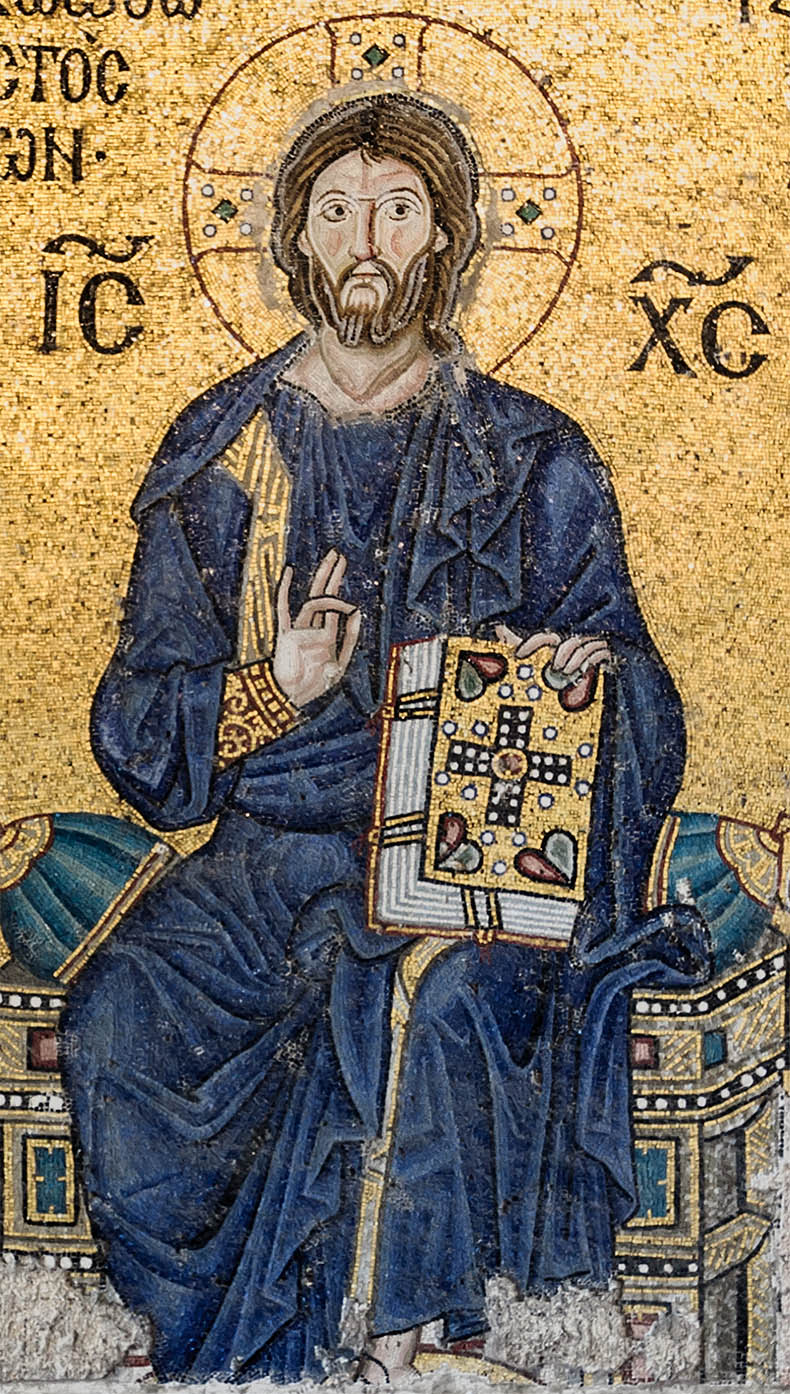 The seated figure of Christ, considerable larger that that of the Emperor and Empress, dominates the standing figures beside it by its size, its dignity, and the depth of the blue in His vestments. These contributory figures lend emphasis to this domination by the slight inclination of the body, the turning of the head, the direction of the eyes, and the gesture of the offering of the gifts. Even the jewels of the imperial robes reappear on the book of the Gospels on on the throne in this progressive ordering of matter, which reaches through the hand of Christ a focal point in the beholder.
The seated figure of Christ, considerable larger that that of the Emperor and Empress, dominates the standing figures beside it by its size, its dignity, and the depth of the blue in His vestments. These contributory figures lend emphasis to this domination by the slight inclination of the body, the turning of the head, the direction of the eyes, and the gesture of the offering of the gifts. Even the jewels of the imperial robes reappear on the book of the Gospels on on the throne in this progressive ordering of matter, which reaches through the hand of Christ a focal point in the beholder.
The face of Christ is in the palest flesh-tinted marble, His eyes are violet and light brown hair, parted in the middle, falls wavy to the back of the neck with three small locks on the brow. The moustache and beard are darker in tone than the hair. The cruciform halo is outlined in deep red. Christ's right hand is raised in blessing and He is clad in a blue chiton and himation. The chiton is dorned with a wide gold clavus. Both vestments give the impression of being of soft wool, with shades from light amethyst to black violet. The blue glass with which they are wrought, however, because of its complete lack of air-holes, has not the luminosity of ninth and tenth century glass used to represent the dye and weave of garments of the figures in the Narthex and Vestibule. Christ's throne is a palace throne of great splendor; He sits on a blue-green cushion with ends capped in rossettes in sealing-wax red and light olive-green. The feet of Christ rest on a circular foot-stool of gold lined with red, only traces of which remain.
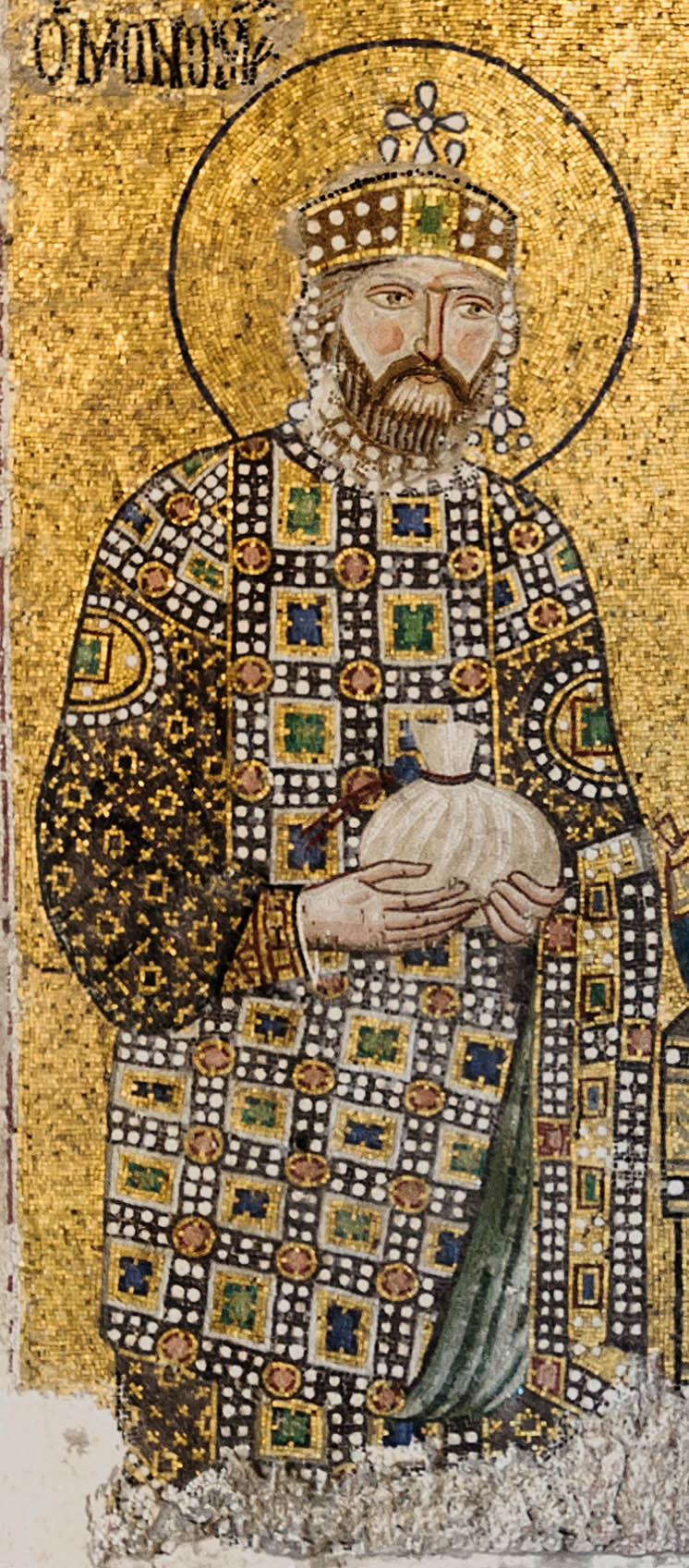
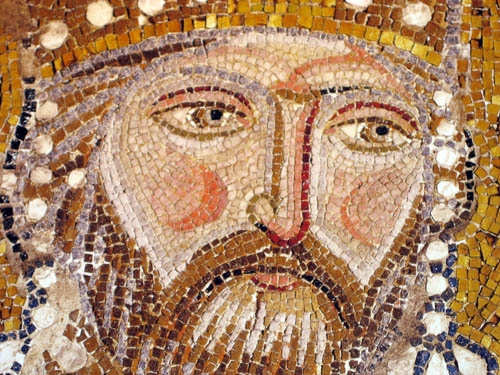
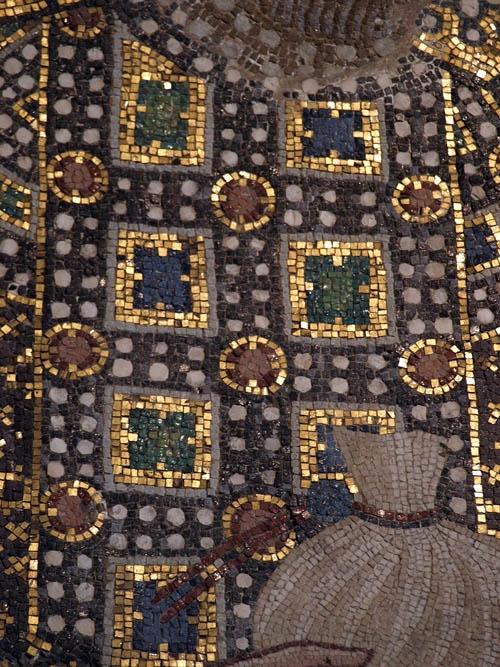 The emperor is offering Christ the traditional apokombiom, his gift of a purse of gold coins. His face is round and ruddy. The emperor wears the stemma, a circlet of gold encrusted with jewels and pearls. The prependulia hanging from the crown are strings of pearls. His nimbus is outlined in blue. Constantine is vested in the imperil chiton, divitisson and loros. The vestments are made of glass mosaic, except for the pearls and the centers of the red gems. His inscription reads Constantine, in Christ the God, Autocrat, faithful King of the Romans, Monomachos.
The emperor is offering Christ the traditional apokombiom, his gift of a purse of gold coins. His face is round and ruddy. The emperor wears the stemma, a circlet of gold encrusted with jewels and pearls. The prependulia hanging from the crown are strings of pearls. His nimbus is outlined in blue. Constantine is vested in the imperil chiton, divitisson and loros. The vestments are made of glass mosaic, except for the pearls and the centers of the red gems. His inscription reads Constantine, in Christ the God, Autocrat, faithful King of the Romans, Monomachos.
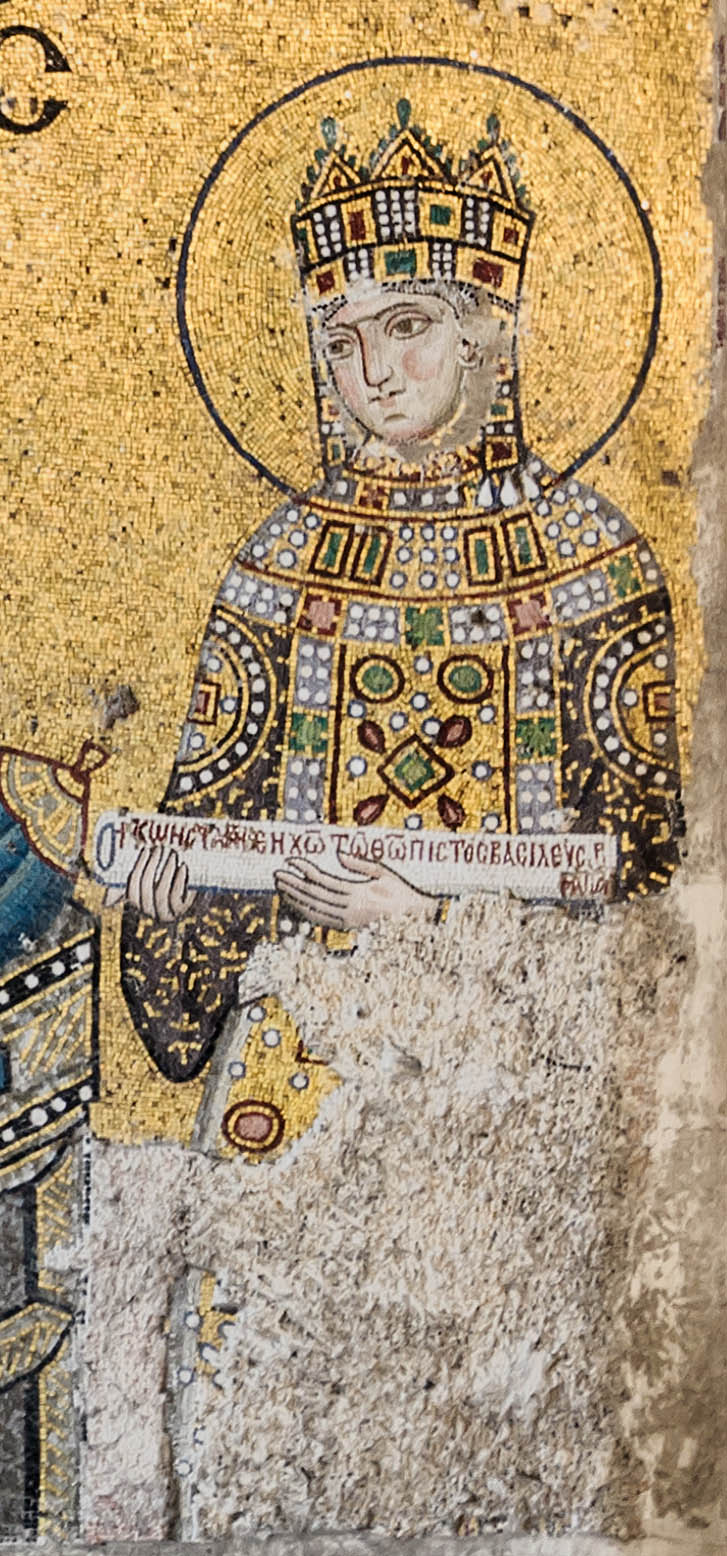
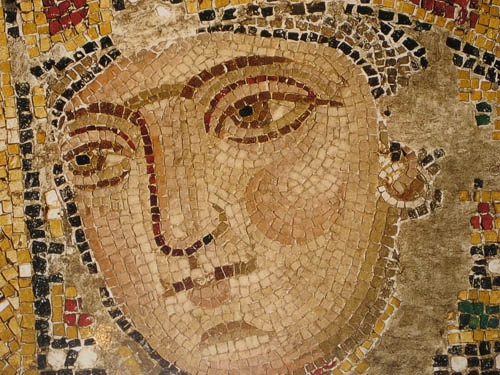
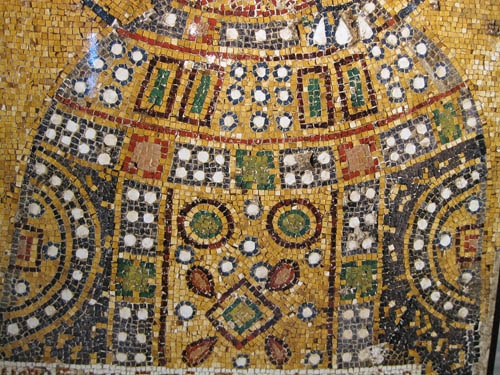 The Byzantine scholar and author Natalia Teteriatnikov believes the money bag in the hands of the Emperor is a unique iconographic feature and commemorates the ongoing ritual of the distribution of thirty pounds of gold coin to the clergy of Hagia Sophia on Holy Saturday. She believes the scroll is not a chrysobull but a list of the clerics and the amount they were to receive from the donation.
The Byzantine scholar and author Natalia Teteriatnikov believes the money bag in the hands of the Emperor is a unique iconographic feature and commemorates the ongoing ritual of the distribution of thirty pounds of gold coin to the clergy of Hagia Sophia on Holy Saturday. She believes the scroll is not a chrysobull but a list of the clerics and the amount they were to receive from the donation.
The figure of the Empress Zoe is much shorter. She holds a scroll of parchment enumerating imperial donations to the Great Church. She has a plump face with a heavy nose, full brow and large yellow-gray eyes. Her rosebud painted mouth is small and her chin has a semi-circular cleft. Her hair seen below the crown is light brown. Her face has been made up like a doll, which reflects her famous and persistent pursuit of youth. Here in realistic portraiture is the doting, still popular old Empress without single wrinkle in her face in spite of her nearly 70 years.
The Empress wears a crown called a modiolos. On either side hang prependulia, which are composed of beryls and garnets separated by pearls. The ear ring of the Empress is a circle of pearls. She is dressed in full Byzantine court attire, clad in chiton, divitission, loros and shoulder piece. A part of the setting bed of the garments can still be seen and we can see the original fresco used by the mosaicist as a guide to setting the cubes. Above the head of the empress are three lines of inscriptions made in black-violet tessellae; they read - Zoe, the most pious Augusta.
Dating of the Zoe Panel
The mosaic was created during the reign of the Empress - Augusta Zoe who reigned in Constantinople from 1028-50. Zoe was married three times. Her first husband was Romanos III Argyros (1028-34); the second was Michael IV the Paphlagonian 1041-2 and after the short reign of her adopted son, Michael V Kalaphates (1041-42), she married Constantine XI Monomachos (1042-55).
Although the head of this mosaic is of Constantine, the rest of the figure was intended to represent either Romanos or Michael. The former of these two emperors seems to be more probable. Therefore the original mosaic dates from between 1028 and 1034.
The reason for the substitution of Constantine's head and name for that of Romanos could be one of three reasons. One, Zoe wanted to update the mosaic to feature her third, last husband and at the same time wanted her own portrait updated, perhaps to make it more pleasing, for her head - and that of Christ was replaced at the same time.
The alternate supposition may, on the contrary, be upheld by certain facts. On the 18th of April 1042 the nephew and successor of Michael IV, Michael V, who had attained the throne through Zoe's devotion, banished his adopted mother to the Island of Prinkipo. On the next day sentence of exile was proclaimed. What followed is well known: a popular revolt supported by Norman mercenaries; the proclamation of Zoe and her sister Theodora as co-empresses; the resistance, flight, and death of Michael; and finally, two months later, the marriage of Zoe with Constantine Monomachos.
The alteration of this mosaic may be considered in the light of these events. We may presume that it was Michael V who, after Zoe's departure from the city, destroyed the effigy of the fallen empress. The portrait of Romanus III would then have been replaced by that of Constantine after mid-June 1042, when Zoe, reinstated and once again married, restored her own portrait. If this is true, the decisive event which determined the the alterations in the mosaic took place in the last days of Michael V's reign.
It hardly seems possible that the image of the empress should have been disfigured during the riots that followed the proclamation of her exile. To be sure Michael and his partisans hated her violently, and judging by what we know of the sacrileges committed by them from, we can assume that the sanctity of the place would not have restrained them from destroying her likeness, but from the very outset of the struggle, the Great Church was probably occupied by supporters of the exiled empress. Thus, the figure could have been mutilated only between the 18th and 20th of April, that is between the dethronement of Zoe and the first disturbances which followed this event two days later. In this case, Michael's action would not have been that of a man taking vengeance on the image of an enemy in a moment of anger. Indeed, the destruction of Zoe's portrait would have done deliberately and with an air of legality. Such an attitude on the part of Michael is more probable in that all his actions against the empress he showed himself - and for and for an obvious reason - exceptionally circumspect in regard to the law. The sentence of exile, to become effective, was approved by the Senate, and afterwards proclaimed by an official. Seldom had the Byzantine usurpers surrounded themselves with such scrupulous procedure.
But neither of the two historical interpretations suggest explains the supersession of one head of Christ by another. No satisfactory explanation of this change is forthcoming, unless it is tentatively assumed that the artist drawing new portraits of Zoe and Constantine supplanted the head of Christ with a new creation in the interests of the unity of the painting.
This explanation may be supported by the fact that the cubes in the faces are relatively larger than those in the hands and even those in the vestments, proving that the original mosaic heads were of finer workmanship.
The previous text has been edited from The Mosaics of Hagia Sophia at Istanbul, Third Prelimary Report, Work Done in 1935-1938, which was published in 1942.
Bob Atchison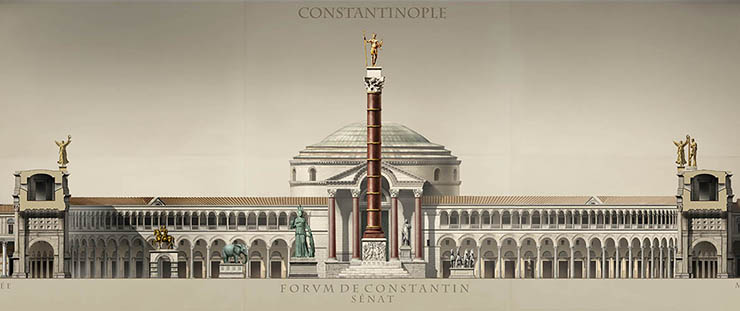

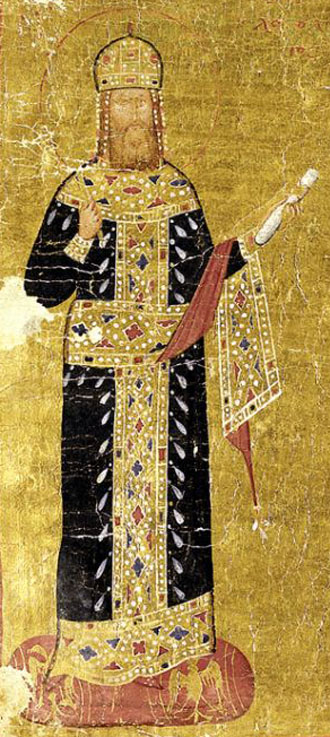
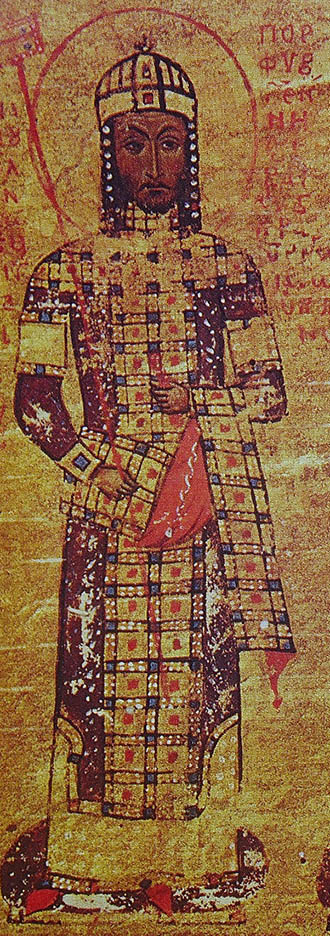
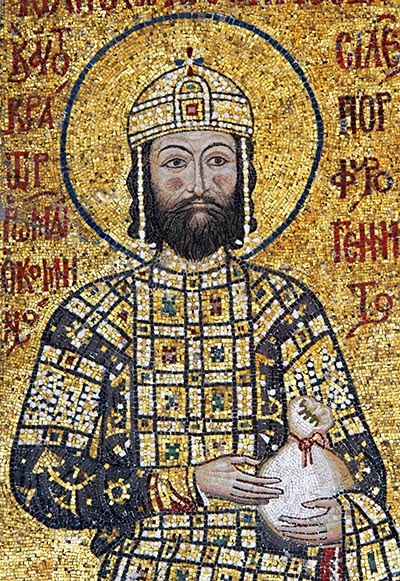
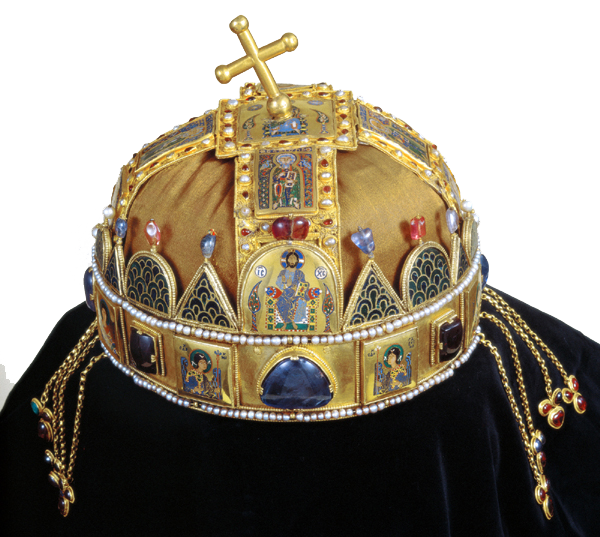
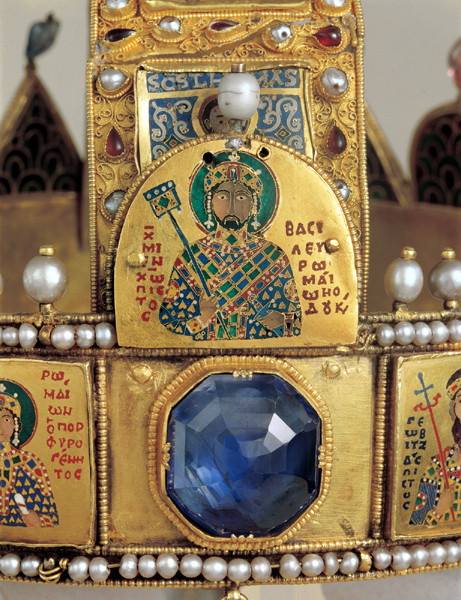
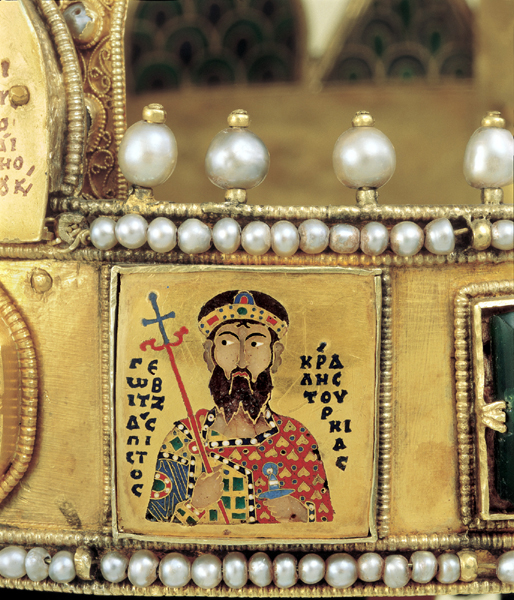
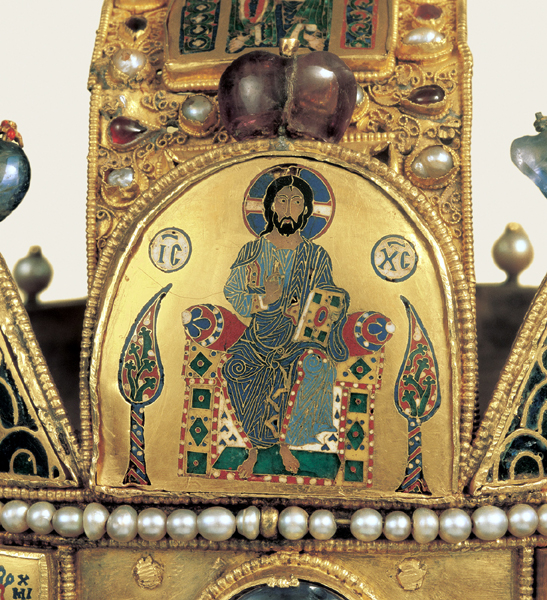
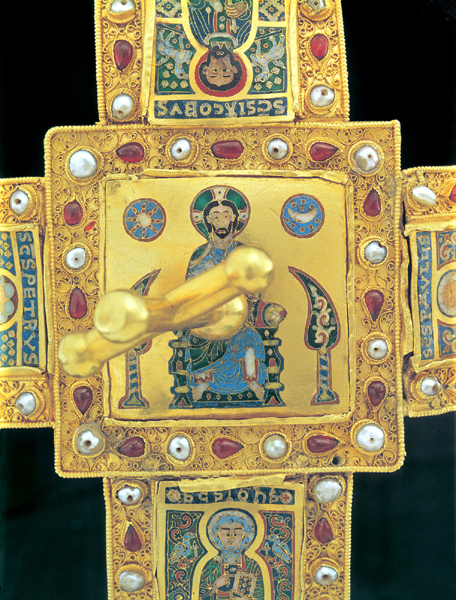
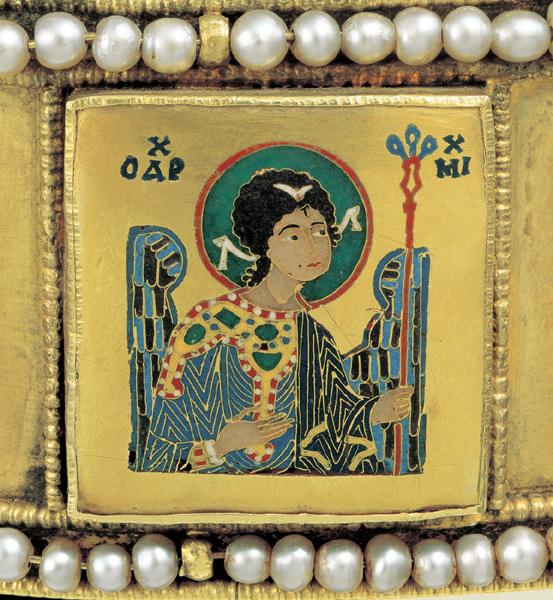
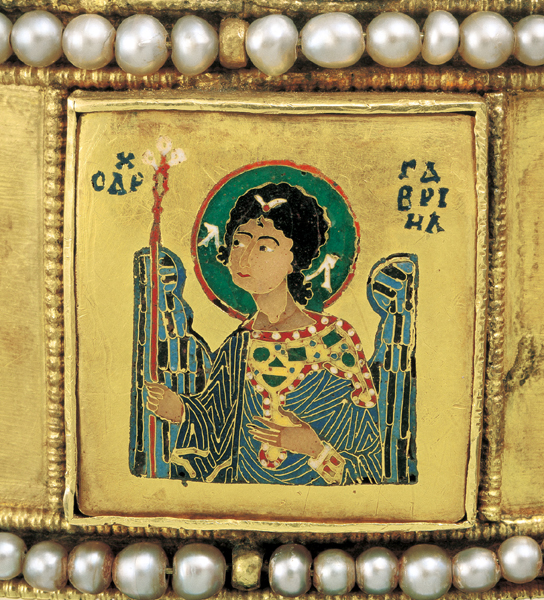
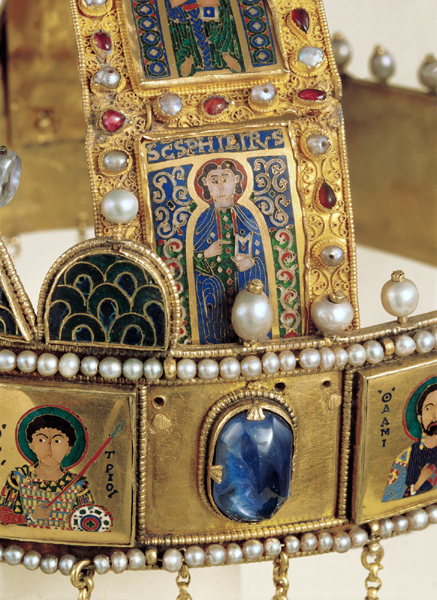
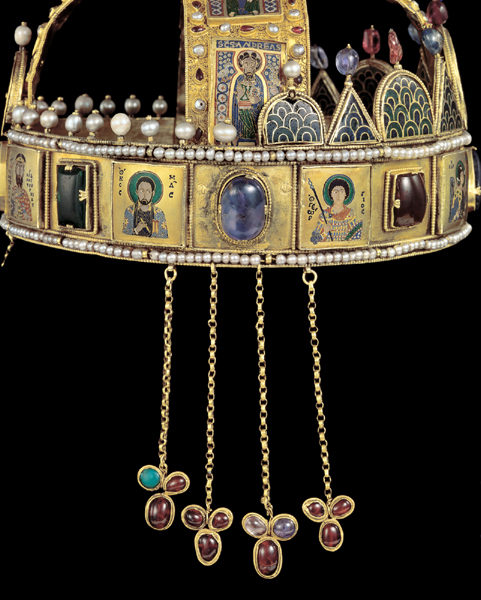
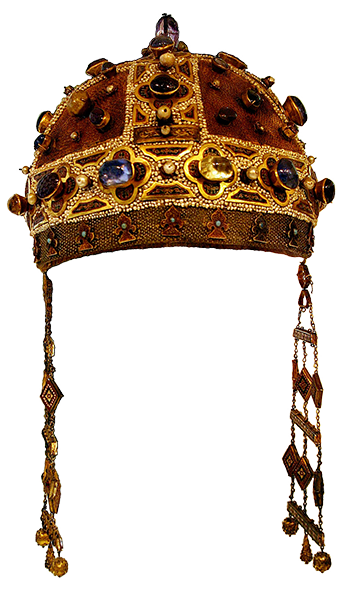


 A vital part of the Imperial ceremony involved the church of Hagia Sophia, which was to the north of the palace and connected to it by public squares, state buildings and passageways from the palace. Most of the time the emperor and his family attended church in the chapels and churches nearest to their private rooms. The emperor was expected to attend services and religious ceremonies all day and frequently into the night. Some of these were quite short and others could include all night vigils. Those that took place deep within the palace were part of the ceremony that was witnessed and participated in by the Imperial court. The public never saw it unless the church service took place outside the confine of the Great Palace and their was a procession to its location.
A vital part of the Imperial ceremony involved the church of Hagia Sophia, which was to the north of the palace and connected to it by public squares, state buildings and passageways from the palace. Most of the time the emperor and his family attended church in the chapels and churches nearest to their private rooms. The emperor was expected to attend services and religious ceremonies all day and frequently into the night. Some of these were quite short and others could include all night vigils. Those that took place deep within the palace were part of the ceremony that was witnessed and participated in by the Imperial court. The public never saw it unless the church service took place outside the confine of the Great Palace and their was a procession to its location.
 Originally the panel was a square 2.40 meters wide and 2.44 meters high. A strip of the mosaic, 35cm. in height, extending across the lower part, is now missing. Above this more tessellae are gone, exposing sections of the setting bed, and there are breaks in the mosaics surrounding the three heads, and in both Constantine inscriptions. These breaks strike an incongruous note and create a vital disorder in the picture. Indeed, scrutiny reveals the fact that all the existing heads have been substituted for earlier ones and that the ensuing tonal discord has rendered the original composition displastic and fragmentary.
Originally the panel was a square 2.40 meters wide and 2.44 meters high. A strip of the mosaic, 35cm. in height, extending across the lower part, is now missing. Above this more tessellae are gone, exposing sections of the setting bed, and there are breaks in the mosaics surrounding the three heads, and in both Constantine inscriptions. These breaks strike an incongruous note and create a vital disorder in the picture. Indeed, scrutiny reveals the fact that all the existing heads have been substituted for earlier ones and that the ensuing tonal discord has rendered the original composition displastic and fragmentary. The seated figure of Christ, considerable larger that that of the Emperor and Empress, dominates the standing figures beside it by its size, its dignity, and the depth of the blue in His vestments. These contributory figures lend emphasis to this domination by the slight inclination of the body, the turning of the head, the direction of the eyes, and the gesture of the offering of the gifts. Even the jewels of the imperial robes reappear on the book of the Gospels on on the throne in this progressive ordering of matter, which reaches through the hand of Christ a focal point in the beholder.
The seated figure of Christ, considerable larger that that of the Emperor and Empress, dominates the standing figures beside it by its size, its dignity, and the depth of the blue in His vestments. These contributory figures lend emphasis to this domination by the slight inclination of the body, the turning of the head, the direction of the eyes, and the gesture of the offering of the gifts. Even the jewels of the imperial robes reappear on the book of the Gospels on on the throne in this progressive ordering of matter, which reaches through the hand of Christ a focal point in the beholder.

 The emperor is offering Christ the traditional apokombiom, his gift of a purse of gold coins. His face is round and ruddy. The emperor wears the stemma, a circlet of gold encrusted with jewels and pearls. The prependulia hanging from the crown are strings of pearls. His nimbus is outlined in blue. Constantine is vested in the imperil chiton, divitisson and loros. The vestments are made of glass mosaic, except for the pearls and the centers of the red gems. His inscription reads Constantine, in Christ the God, Autocrat, faithful King of the Romans, Monomachos.
The emperor is offering Christ the traditional apokombiom, his gift of a purse of gold coins. His face is round and ruddy. The emperor wears the stemma, a circlet of gold encrusted with jewels and pearls. The prependulia hanging from the crown are strings of pearls. His nimbus is outlined in blue. Constantine is vested in the imperil chiton, divitisson and loros. The vestments are made of glass mosaic, except for the pearls and the centers of the red gems. His inscription reads Constantine, in Christ the God, Autocrat, faithful King of the Romans, Monomachos.

 The Byzantine scholar and author Natalia Teteriatnikov believes the money bag in the hands of the Emperor is a unique iconographic feature and commemorates the ongoing ritual of the distribution of thirty pounds of gold coin to the clergy of Hagia Sophia on Holy Saturday. She believes the scroll is not a chrysobull but a list of the clerics and the amount they were to receive from the donation.
The Byzantine scholar and author Natalia Teteriatnikov believes the money bag in the hands of the Emperor is a unique iconographic feature and commemorates the ongoing ritual of the distribution of thirty pounds of gold coin to the clergy of Hagia Sophia on Holy Saturday. She believes the scroll is not a chrysobull but a list of the clerics and the amount they were to receive from the donation.




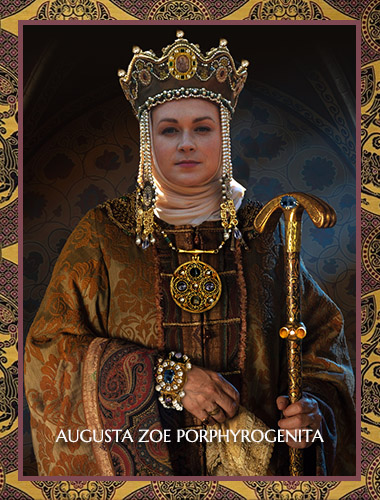

 click here for icons of christ
click here for icons of christ click here for icons of the theotokos
click here for icons of the theotokos click here for icons of angels
click here for icons of angels click here for icons of saints
click here for icons of saints








